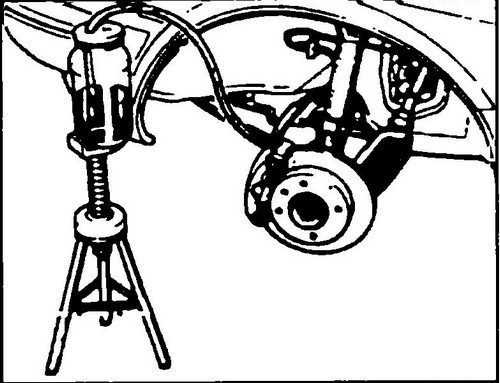Removal of air from the brake system
Upon completion of any work on the brake system (or on the clutch drive), as well as, if necessary, during operation (“failure” of the brake pedal, incomplete disengagement of the clutch), it is necessary to remove air from the hydraulic system. Before pumping, you should find the place of the leak and eliminate its cause. Since on VW T4 cars the compensation tank simultaneously serves the brake system and the clutch hydraulic drive, usually, in emergency cases, both hydraulic drives have to be pumped, which is done in the same way.
Rice. 456 Removal of air from the brake system
There are two different ways to bleed the brake system.
According to the first method, the pressure in the system is created by repeatedly pressing the brake (clutch) pedal. The second way is that the pressure is created by a special device installed on the expansion tank. In the first case, an assistant or a special object (rail, etc.) is needed to hold the brake pedal in the depressed position (the assistant must work with the working wheel mechanisms / clutch slave cylinder at this time). If the cause of air entering the system is work on a certain wheel, then pumping should be started from it, if not, then the following sequence is recommended:
- brake mechanism of the rear right wheel;
- rear left wheel brake;
- brake mechanism of the front right wheel;
- the brake mechanism of a forward left wheel.
Safety measures:
- maintain the fluid level in the compensation tank at all times to prevent air from entering the hydraulic drive;
- when the circuit is open, do not press the pressure regulator lever in the brake system.
Sequence of actions:
♦ Remove the protective rubber cap (if any) from the bleeder valve of the corresponding wheel cylinder/caliper (clutch slave cylinder).
♦ Put a thin hose on the fitting, lower the other end into a container with brake fluid (the fluid acts as a non-return valve).
♦ Pressurize the system as described above.
♦ Loosen the bleeder screw half a turn and let out the brake fluid (with or without air bubbles).
The most convenient way to monitor the flowing fluid is to use a transparent hose from medical transfusion systems. When the fluid stops flowing out, tighten the fitting. ♦ Repeat this operation on all wheels in turn and until no more gas bubbles appear in the liquid, or until the brake pedal becomes “hard”.
Sometimes, by the effort on the pedals, it is difficult to determine the end of bleeding the clutch hydraulic drive. In this case, the end of the process is judged by the normal operation of the drive rod (visually, together). ♦ Dismantle the bleed hose, put a protective cap on the fitting.
Brake Fluid Replacement
The fluid is replaced either according to its condition (changing the color of the fluid “by eye”) or 2 years after refueling.
In this case, perform all operations as when removing air, but stop the process after clean brake fluid begins to flow through the hose. ♦ Do not forget to add fluid to the expansion tank regularly. We add that the clutch drive will also have to be pumped.
